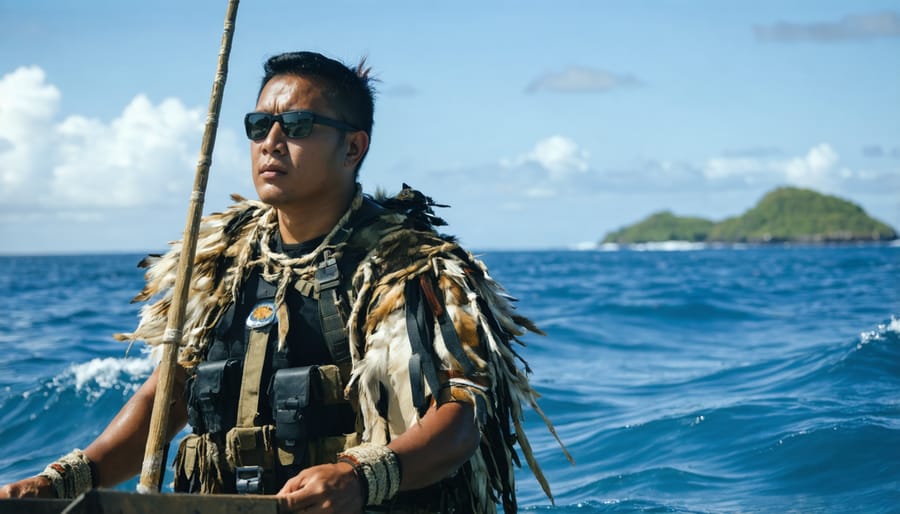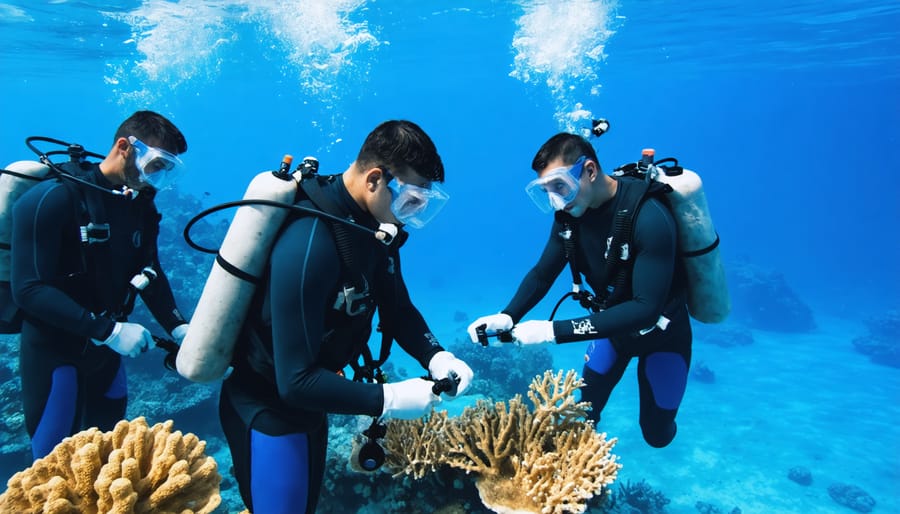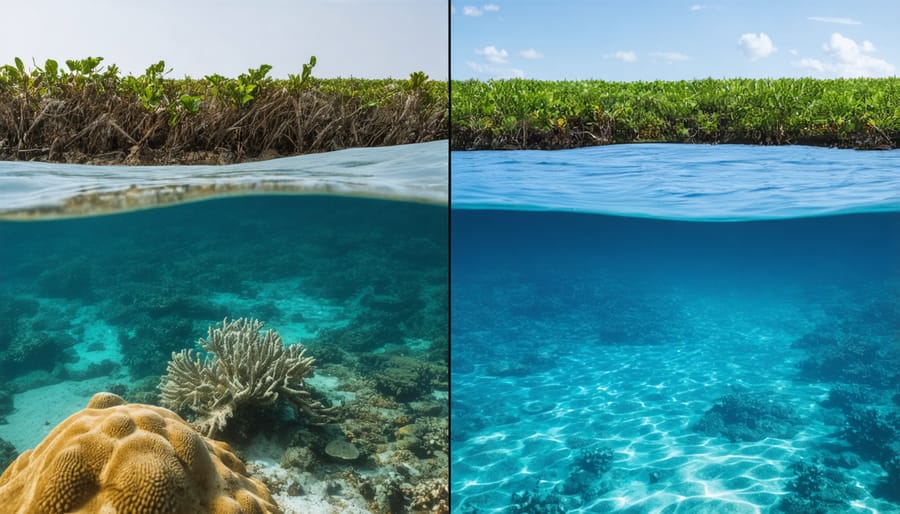
Along the rugged coastlines of North America, a powerful alliance is emerging between Indigenous communities and marine conservation efforts. The Tribal Marine Stewards Network represents a groundbreaking partnership that combines centuries of traditional ecological knowledge with modern scientific approaches to protect our oceans’ vital ecosystems. These Indigenous-led initiatives are transforming marine conservation by establishing a coordinated system of tribal nations working together to monitor, protect, and restore coastal waters that have been their ancestral homes for millennia.
This innovative network empowers tribal communities to serve as the primary guardians of their marine territories, implementing conservation strategies that reflect both their cultural values and cutting-edge environmental science. From conducting sophisticated marine surveys to enforcing protected areas and leading habitat restoration projects, these stewards are demonstrating how traditional wisdom and contemporary conservation practices can work in harmony to address today’s most pressing marine challenges.
The impact of this collaborative approach extends far beyond individual tribal territories, creating a model for inclusive, effective marine conservation that respects Indigenous sovereignty while advancing global biodiversity protection goals. As climate change and human activities continue to threaten marine ecosystems, the Tribal Marine Stewards Network offers hope and practical solutions for preserving our oceans for future generations.
Traditional Knowledge Meets Modern Conservation
Ancient Wisdom in Modern Times
Indigenous communities have long practiced effective traditional marine management practices that modern science is now recognizing as remarkably sophisticated. The rotational harvesting of shellfish beds, practiced by coastal tribes for generations, has proven highly effective in maintaining sustainable populations. In the Pacific Northwest, Indigenous communities traditionally established seasonal fishing zones, allowing fish stocks to replenish naturally during specific periods.
The practice of reef gleaning, where communities carefully harvest marine resources during low tide, demonstrates an intimate understanding of tidal patterns and species lifecycles. Many tribes implemented size-based harvesting restrictions long before modern fishing regulations, ensuring that juvenile specimens could reach maturity and reproduce.
These time-tested methods have shown remarkable resilience and sustainability. For instance, traditional Hawaiian fish ponds, known as loko i’a, represent an advanced form of aquaculture that maintains ecosystem balance while providing consistent food sources. Similar success stories can be found in the traditional management of mangrove forests by coastal communities in Southeast Asia, where controlled harvesting has preserved these crucial marine nurseries for centuries.

Bridging Two Worlds
In tribal marine steward networks, ancient wisdom meets modern science in a powerful synergy. Indigenous communities draw upon centuries of traditional ecological knowledge passed down through generations, combining these time-tested practices with contemporary conservation techniques. This integration creates a comprehensive approach to marine resource management that benefits both ecosystems and communities.
Traditional practices, such as seasonal harvesting cycles and spatial management of marine resources, are validated and enhanced by scientific monitoring methods. Indigenous stewards use modern GPS technology and data collection tools while incorporating traditional navigation techniques and ecological indicators. For example, many communities combine ancestral knowledge of tide patterns and marine species behavior with satellite tracking and population surveys.
The bridging of these two knowledge systems has proven remarkably effective. Traditional ceremonies and cultural protocols guide conservation activities, while scientific research provides quantitative data to support management decisions. This collaborative approach has led to more successful conservation outcomes, as it ensures that both cultural values and scientific objectives are met. The result is a holistic framework that respects indigenous heritage while embracing innovative conservation strategies for the future.
Structure and Operation of Tribal Marine Networks
Network Organization
The Tribal Marine Stewards Network operates through a collaborative governance structure that empowers coastal Indigenous communities to lead marine conservation efforts. At its core, Indigenous marine leadership drives decision-making processes, ensuring that traditional ecological knowledge remains central to conservation strategies.
The network is organized into regional hubs, each representing different tribal territories and marine ecosystems. These hubs function semi-autonomously while maintaining strong connections through regular inter-tribal meetings and knowledge-sharing sessions. A council of tribal elders and environmental specialists provides guidance and oversight, helping balance traditional practices with modern conservation techniques.
Each participating tribe designates marine stewards who serve as both guardians and educators within their communities. These stewards undergo comprehensive training that combines traditional teachings with contemporary scientific methods, enabling them to effectively monitor marine health, collect data, and implement conservation measures.
The network’s organizational structure emphasizes horizontal collaboration rather than hierarchical management. Regular gatherings, both virtual and in-person, facilitate the exchange of best practices and strengthen relationships between member tribes. Working groups focused on specific issues – such as water quality monitoring, species protection, or habitat restoration – allow for specialized expertise development while maintaining cross-cultural dialogue.
To ensure sustainability, the network maintains partnerships with scientific institutions, government agencies, and environmental organizations. These relationships provide additional resources and technical support while respecting tribal sovereignty and traditional knowledge systems. Funding mechanisms are designed to support long-term program stability while maintaining tribal autonomy in decision-making processes.
This organizational approach has proven effective in creating a resilient, adaptive network that successfully bridges traditional wisdom with modern conservation practices.

Daily Operations and Responsibilities
Tribal marine stewards engage in a diverse range of daily activities that combine traditional ecological knowledge with modern conservation practices. Their primary responsibilities include conducting regular shoreline monitoring, where they document changes in tide patterns, marine species populations, and habitat conditions. During these patrols, stewards collect valuable data on water quality, temperature, and salinity levels while keeping detailed records of marine wildlife sightings.
A significant portion of their work involves species monitoring and protection, particularly focusing on culturally significant species such as salmon, shellfish, and marine mammals. Stewards actively participate in habitat restoration projects, including eelgrass bed preservation, kelp forest monitoring, and shoreline cleanup initiatives. They also play a crucial role in identifying and reporting potential threats to marine ecosystems, such as oil spills, illegal fishing activities, or unusual wildlife behavior patterns.
Education and community outreach form another vital component of their duties. Stewards regularly conduct workshops for local communities, sharing traditional knowledge and conservation practices with younger generations. They collaborate with marine scientists and environmental agencies, contributing their unique perspective to research projects and conservation planning.
During peak seasons, stewards assist in managing sustainable harvesting practices, ensuring traditional fishing methods are preserved while maintaining ecological balance. They also participate in emergency response efforts, such as marine mammal strandings or environmental disasters, providing crucial local knowledge and immediate response capabilities.
The stewards’ work often extends to using modern technology, including GPS mapping, water testing equipment, and digital documentation tools, while maintaining traditional observation and monitoring methods passed down through generations.
Success Stories and Impact
Ecosystem Recovery
The Tribal Marine Stewards Network has achieved remarkable success in ecosystem recovery through targeted restoration projects and species protection initiatives. Along the Pacific Northwest coast, tribal stewards have led kelp forest restoration efforts, successfully reestablishing these vital marine habitats that provide shelter and sustenance for numerous species, including endangered salmon populations.
In California, network members have worked to protect and restore abalone populations, combining traditional harvesting knowledge with modern conservation techniques. Their efforts have included establishing protected breeding areas and implementing sustainable harvesting practices that allow populations to recover while maintaining cultural connections to these important species.
Tribal stewards in Alaska have spearheaded successful initiatives to protect marine mammal populations, particularly sea otters and seals, which play crucial roles in maintaining ecosystem balance. Through careful monitoring and habitat protection, several communities have documented increasing numbers of these keystone species returning to their traditional waters.
One particularly notable achievement has been the restoration of eelgrass beds in tribal waters, which serve as crucial nursery grounds for juvenile fish and invertebrates. Using a combination of traditional ecological knowledge and contemporary scientific methods, stewards have successfully replanted and protected these underwater meadows, leading to measurable increases in local marine biodiversity.
These recovery efforts demonstrate the effectiveness of combining Indigenous knowledge with modern conservation practices, creating resilient ecosystems that support both marine life and coastal communities.

Community Benefits
The establishment of tribal marine stewards networks has generated significant positive marine conservation impact on communities, creating ripple effects throughout Indigenous territories. These networks have become powerful catalysts for economic development, providing sustainable employment opportunities through monitoring, research, and ecotourism initiatives.
Indigenous communities participating in marine stewardship programs report increased food security through better management of traditional fishing grounds and enhanced protection of culturally significant species. Young community members gain valuable skills through training programs, combining traditional ecological knowledge with modern scientific methods, which creates career pathways in environmental science and conservation.
The networks strengthen cultural connections by facilitating the transfer of traditional knowledge between generations. Elders work alongside younger stewards, sharing ancient practices and stories while incorporating new conservation techniques. This collaboration helps preserve Indigenous languages, as traditional names and concepts for marine species and ecological processes remain in active use.
Educational opportunities have expanded significantly, with many communities establishing youth programs that combine hands-on marine science experience with cultural teachings. These initiatives have led to increased graduation rates and growing interest in environmental careers among Indigenous youth. Additionally, the presence of stewardship networks has enhanced community autonomy in resource management decisions, leading to more effective conservation strategies that reflect local values and needs.
Future of Indigenous Marine Stewardship
Growing Recognition
Recent years have marked a significant shift in how governments and international organizations view and value Indigenous conservation approaches to marine resource management. This growing recognition stems from mounting evidence that traditional ecological knowledge and stewardship practices often lead to better conservation outcomes than conventional Western methods alone.
Major environmental organizations, including the International Union for Conservation of Nature (IUCN) and the United Nations Environment Programme, have formally acknowledged the effectiveness of Indigenous marine management systems. Several coastal nations, such as Canada, Australia, and New Zealand, have begun incorporating tribal stewardship programs into their official marine protection frameworks.
This acceptance has manifested in various ways, from increased funding opportunities to formal partnerships between government agencies and tribal communities. For instance, the Great Barrier Reef Marine Park Authority now actively collaborates with Traditional Owners in reef management decisions, while in British Columbia, First Nations communities have established formal agreements with federal authorities to co-manage marine protected areas.
The success of these partnerships has led to a broader understanding that effective marine conservation requires diverse knowledge systems working in harmony. This recognition has opened doors for more Indigenous communities to establish their own marine steward networks, supported by both government resources and conservation organizations.
Expansion Opportunities
The potential for expanding tribal marine stewards networks presents exciting opportunities for scaling up indigenous-led conservation efforts worldwide. Success stories from existing networks have sparked interest among other coastal indigenous communities seeking to establish similar programs. In North America alone, several tribes have begun developing frameworks for new stewardship initiatives, with particular interest growing among Arctic and Great Lakes communities.
International expansion shows promise, with indigenous groups in Australia, New Zealand, and Pacific Island nations exploring adaptations of the stewardship model to their local contexts. These emerging networks benefit from the lessons learned by established programs while incorporating their own traditional ecological knowledge and cultural practices.
Technology is playing an increasingly important role in network expansion. Digital platforms enable knowledge sharing between distant communities, while mobile apps and monitoring devices enhance data collection capabilities. Some networks are exploring the use of drones and satellite imagery for more comprehensive ecosystem surveillance.
Funding opportunities through environmental grants, government programs, and private sector partnerships are becoming more accessible as the value of indigenous stewardship gains recognition. This financial support enables new networks to establish infrastructure, acquire necessary equipment, and provide training for community members.
Educational institutions are also contributing to expansion efforts by developing specialized training programs that combine traditional knowledge with modern conservation science, preparing the next generation of indigenous marine stewards.
The vital role of tribal marine steward networks in protecting our oceans cannot be overstated. These networks represent a powerful fusion of traditional ecological knowledge and modern conservation practices, creating a comprehensive approach to marine resource management that benefits both local communities and global biodiversity.
By supporting and expanding these networks, we strengthen not only our marine conservation efforts but also preserve centuries of Indigenous wisdom that has maintained healthy ocean ecosystems. The success stories from existing tribal stewardship programs demonstrate how traditional practices, when combined with contemporary scientific methods, create more effective and sustainable conservation outcomes.
Looking ahead, the expansion of tribal marine steward networks offers tremendous potential for addressing critical challenges in marine conservation. From monitoring changing ocean conditions to protecting endangered species and maintaining sustainable fisheries, these networks provide a model for inclusive, knowledge-based conservation that respects both nature and culture.
The future of marine conservation lies in embracing diverse perspectives and approaches. Supporting tribal marine steward networks through funding, policy support, and collaborative partnerships will be crucial in building resilient coastal communities and protecting marine ecosystems for future generations. By amplifying Indigenous voices and traditional knowledge in marine conservation, we create a more equitable and effective approach to ocean stewardship that benefits all life on Earth.
jessica
Ava Singh is an environmental writer and marine sustainability advocate with a deep commitment to protecting the world's oceans and coastal communities. With a background in environmental policy and a passion for storytelling, Ava brings complex topics to life through clear, engaging content that educates and empowers readers. At the Marine Biodiversity & Sustainability Learning Center, Ava focuses on sharing impactful stories about community engagement, policy innovations, and conservation strategies. Her writing bridges the gap between science and the public, encouraging people to take part in preserving marine biodiversity. When she’s not writing, Ava collaborates with local initiatives to promote eco-conscious living and sustainable development, ensuring her work makes a difference both on the page and in the real world.
